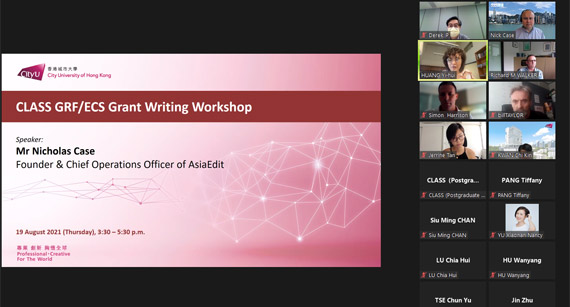
In the previous blogs, we talked about searching and assessing reference papers for your literature review, and shared tips on organising and writing the content. Let’s look now at how to conclude your literature review.
One of the aims of writing the literature review is to define the purpose and contribution of your own study. Your review should therefore cover the points listed below to provide the rationale or justification for your study:
⦁ gaps in the research
⦁ limitations of previous studies
⦁ weaknesses or lack of support for existing theories




Quick Takeaways:
The English language has a rich history of borrowing words from other languages, especially from Latin. Latin abbreviations such as ‘a.m.’, ‘p.m.’ and ‘CV’ have become part of our everyday vocabulary. Such abbreviations are also frequently used in academic writing, from the ‘Ph.D.’ in the affiliation section to the ‘i.e.’, ‘e.g.’, ‘et al.’, and ‘QED’ in the rest of the paper.
This guide explains when and how to correctly use ‘et al.’ in a research paper.
You need to state clearly what your study intends to achieve and why it is important.
It is not sufficient to simply say something like, “there is a gap in the research or literature”. Your readers might think that the gap exists only because there is no reason to fill such gap.
Then what should you consider including in the conclusion of your literature review?
First, you must be clear about what the purpose or objective of your study is. For example, you need to make it clear whether your study:
⦁ is designed to answer a specific question or solve a specific problem
⦁ is an experimental study looking for a cause and effect relationship
⦁ is a correlational study looking for relationships between variables
⦁ compares different clinical or psychological treatments or interventions
⦁ presents a new technique or an adaptation of an existing one
⦁ is a meta-analysis or review of previous studies
Try to be specific about the significance of your study and have a clear idea about what or who will benefit from it.
To give you some examples, a benefit might include:
⦁ advancing an existing theory or developing a new one
⦁ providing a new technique that will benefit future researchers
⦁ presenting a new material or product, or refining an existing one that will benefit industry
⦁ proposing a treatment or intervention that will aid clinicians and patients
⦁ providing evidence that can be used to improve government policy-making
It is important to remember that the conclusion only needs to be a few sentences long. So, do not write too much.
You can follow the steps and adapt the sample expressions listed below:
Step #1: Start with a sentence to highlight the research gap
You may consider using one of these examples:
Despite the aforementioned theoretical inferences, no study to date has provided empirical support for the hypothesized effects
Step #2: State what you did to address the problem
Try using a sentence similar to one of these:
Therefore, in a series of experiments, we explored the direct effects of a on b and c, and tested whether m had a moderating influence on these effects
Step #3: Summarise how the findings will contribute to theory and/or practice
You may consider writing in one of these ways:
The results not only provide support for the theory, but also have practical implications for industry and government decision makers
Confirmation of the suitability of the intervention in this population will provide an alternative choice of treatment for this condition, which will benefit both patients and clinicians.
Putting those sample expressions together, we have the following example literature review conclusions.
“Given the lack of evidence for the applicability of this psychological intervention in Asian populations, we conducted a randomised control trial with a sample of patients who attended the clinic at ABC Hospital. Confirmation of the suitability of the intervention in this population will provide an alternative choice of treatment for this condition, which will benefit both patients and clinicians.”
But, always remember that the wording you use will differ depending on the nature of your study.
And no matter how different the wording you use is, the fundamental elements of this summary should not change, you must cover the following:
⦁ make clear the research gap
⦁ explain how you set out to address the problem
⦁ and why it was important to do so
Wondering why some abbreviations such as ‘et al.’ and ‘e.g.’ use periods, whereas others such as CV and AD don’t? Periods are typically used if the abbreviations include lowercase or mixed-case letters. They’re usually not used with abbreviations containing only uppercase letters.
Our latest online workshop built on the success of face-to-face workshops we developed specifically for local universities. Over 30 faculty members joined the session, presented by our Chief Operating Officer, Mr Nick Case, to learn from our case studies on editing research proposals.
The response to our workshop, which included a constructive and insightful Q&A session, was very positive.Drawing on our extensive experience working with hundreds of Hong Kong researchers targeting the GRF and ECS every year, we used examples of poor and subsequently improved proposals to show the attendees how they can make their applications stand out. The response to our workshop, which included a constructive and insightful Q&A session, was very positive.Drawing on our extensive experience working with hundreds of Hong Kong researchers targeting the GRF and ECS every year, we used examples of poor and subsequently improved proposals to show the attendees how they can make their applications stand out. The response to our workshop, which included a constructive and insightful Q&A session, was very positive.Drawing on our extensive experience working with hundreds of Hong Kong researchers targeting the GRF and ECS every year, we used examples of poor and subsequently improved proposals to show the attendees how they can make their applications stand out.

Wondering why some abbreviations such as ‘et al.’ and ‘e.g.’ use periods, whereas others such as CV and AD don’t? Periods are typically used if the abbreviations include lowercase or mixed-case letters. They’re usually not used with abbreviations containing only uppercase letters.
Check out AsiaEdit’s professional research grant proposal editing service.
Read more about our training services covering all aspects of academic writing tailored for local institutions.
More resources on research grant proposal writing: On-demand Webinars
Preparing an effective research proposal – Your guide to successful funding application
Preparing an effective research proposal – Your guide to successful funding application (Part 2)

Rachel first joined us as a freelance editor in 2001, while completing her PhD. After spending a few years as a post-doctoral researcher and then lecturing in psychology, she returned to us in 2010 and focused her career on academic editing. She took on the role of Assistant Chief Editor in 2018, and became co-Chief-Editor in 2020. Unable to leave academia behind completely, she also teaches Psychology at an English-speaking university in Italy, where she is now based. With extensive experience in both academia and publishing, Rachel has an excellent overview of both the client and editor sides of the business.



Your Schedule, Our Prime Concern AsiaEdit takes a personalised approach to editing.
We are East Asia's leading academic editing partner. Established in 1996 and headquartered in Hong Kong, we have strong connections with academics and renowned faculty in the region, built by delivering quality work on schedule for more than 25 years.
Suite 2101, 99 Hennessy Road,
Wan Chai, Hong Kong
9:00am – 6:00pm
(+852) 2590 6588
